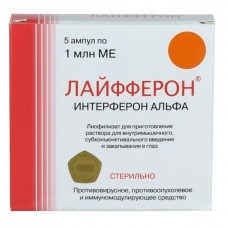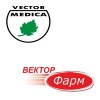Expiration date: 05/2026
Release form and composition:
Lyophilisate for preparation of solution for intramuscular, subconjunctival administration and instillation into the eyes of the prepared solution is colorless, transparent or slightly opalescent.
1 vial contains:
interferon Alfa-2b human recombinant
- 500 thousand IU
- 1 million IU
- 3 million IU
- 5 million IU
Auxiliary substances: sodium chloride, sodium hydrogen phosphate, dodecahydrate, sodium dihydrogen phosphate dihydrate, D-sorbitol, urea, reopoligljukin.
Ampoules (5) - packaging sells contoured (1) - packs of cardboard.
Ampoules (5) - packaging sells contoured (2) - packs of cardboard.
Pharmacological action:
Human recombinant interferon Alfa-2b protein synthesized by strain Escherichia ci, the genetic machinery that built two of the gene human leukocyte interferon alpha-2b. The drug is identical to human leukocyte interferon alpha-2b. Has antiviral, antitumor and immunomodulatory activity.
Prolonged use of the drug in individuals may cause the appearance of antibodies to interferon, which leads to lower efficiency.
Pharmacokinetics:
For parenteral administration the drug undergoes biotransformation, partly excreted unchanged (mainly kidneys).
Indications:
Adults in the complex therapy:
- moderate and severe forms of acute viral hepatitis b (early jaundiced period to 5-day jaundice at a later date the appointment of the drug is less effective in developing hepatic coma and cholestatic disease drug ineffective)
- acute prolonged hepatitis and chronic active hepatitis b, C and D with no signs of cirrhosis and signs of liver cirrhosis
- viral (flu, adenovirus, enterovirus, herpes, mumps), virus and bacterial and mycoplasmal meningoencephalitis (the use of the drug is most effective in the first 4 days of illness)
- viral conjunctivitis, keratoconjunctivitis, keratitis, keratouveitis
- kidney cancer stage IV, hairy cell leukemia, malignant lymphomas of the skin (mycosis fungoides, primary retikulez), Kaposi's sarcoma, basal cell and squamous cell skin cancer, keratoacanthoma, chronic myeloid leukemia, histiocytosis-X, subleukemic mieloza, essential thrombocytopenia
- multiple sclerosis.
Children in the complex therapy:
- acute lymphoblastic leukemia in remission after inductive chemotherapy (4-5 months of remission)
- juvenile respiratory papillomatosis of the larynx, starting from the next day after the removal of papillomas.
Dosing regimen:
The drug is injected in/m, in the hearth or under the lesion, or subconjunctival local.
The/m introduction
In acute hepatitis b drug is administered in 1 million ME 2 times/day for 5-6 days, then reduce the dose of 1 million ME/day and administered for 5 days. If necessary (after controlling biochemical blood tests) the treatment can be continued with the introduction of 1 million ME 2 times a week for 2 weeks. Heading dose is 15 to 21 million with ME.
Acute, protracted and chronic active hepatitis b with the exclusion of Delta-infection and no cirrhosis of the liver the drug is administered to 1 million ME 2 times a week for 1-2 months. In the absence of the effect of treatment can be prolonged up to 3-6 months or after 1-2 months of therapy to hold the same 2-3 courses with an interval of 1-6 months.
Acute, protracted and chronic active hepatitis C without signs of cirrhosis of the liver the drug is administered for 3 million ME 3 times a week for 6-8 months. In the absence of effective treatment extend to 12 months. A second course of treatment - 3-6 months.
In chronic active hepatitis D without signs of cirrhosis of the liver the drug is administered at 500 thousand-1 million ME/day, 2 times per week for 1 month. A second course of treatment after 1-6 months.
In chronic active hepatitis b and D cirrhosis of the liver the drug is administered at 250-500 thousand ME/day, 2 times per week for 1 month. If signs of decompensation conducted the same repeated courses at intervals of not less than 2 months.
When hairy cell leukemia drug is administered daily for 3-6 million ME for 2 months. After normalization of the haemogram daily dose is reduced to 1-2 million ME, then administered at a maintenance dose of 3 million ME 2 times a week for 6-7 weeks. The total amount of the drug is 420-600 million ME and more.
In acute lymphoblastic leukemia in children in the period of remission after inductive chemotherapy (for 4-5 months. remission), and 1 million for ME 1 time a week for 6 months, then 1 every 2 weeks for 24 months. At the same time supportive chemotherapy .
In chronic myeloid leukemia, the drug is administered for 3 million ME daily or 6 million ME through the day. Duration of treatment: 10 weeks to 6 months.
When histiocytosis X drug is administered 3 million IU/day for 1 month. Repeated courses with 1-2 - month intervals during the 1-3 years.
In kidney cancer, the drug is administered 3 million IU/day for 10 days. Repeated courses (3-9 and above) are at intervals of 3 weeks. The total dose is from 120 to 300 million IU million IU, and more.
Subleukemic myelosis and thrombocytopenia essential for the correction of hyperthrombocytosis the drug is administered to 1 million ME every day or every other day for 20 days.
Malignant lymphoma and Kaposi sarcoma the drug is administered 3 million IU/day every day for 10 days in combination with cytotoxic drugs (prospidin, cyclophosphamide) and corticosteroids. In the tumor stage of mycosis fungoides and retikulosarkomatose advisable to alternate I/m administration of the drug for 3 million ME and vnutrio?agovogo 2 million ME within 10 days.
Viral, viral-bacterial and Mycoplasma meningoencephalitis the drug is administered to 1 million ME 2 times/day for 10 days in the combined therapy with antiviral and antibacterial chemotherapy. The dose and scheme of treatment set individually, depending on the severity of the patient's condition.
Patients with erythrodermic stage of mycosis fungoides when the increase in body temperature above 39°C and in case of exacerbation of the drug should be discontinued. In case of insufficient therapeutic effect after 10-14 days, prescribe a second course of therapy. After reaching the clinical effect of prescribed maintenance therapy for 3 million ME 1 time per week for 6-7 weeks.
In juvenile respiratory papillomatosis of the larynx the drug is administered at 100-150 thousand ME per kg of body weight daily for 45-50 days, then the same dose 3 times a week for 1 month. The second and third course conducted at intervals of 2-6 months.
In multiple sclerosis the drug is prescribed for 1 million ME with pyramid syndrome, 3 times/day, with cerebellar syndrome - 1-2 times/day for 10 days, followed by administration of 1 million ME 1 time per week for 5-6 months. The total amount of the drug is 50-60 million ME.
Persons with a high pyrogenic reactions (body temperature 39°C and above) on the introduction of the drug to the simultaneous administration of indomethacin.
Perifocal introduction
While basal cell and squamous cell carcinoma, keratoakantoma the drug is injected under the lesion 1 million ME 1 time/day daily for 10 days. In the case of pronounced local inflammatory reactions introduction under the lesion is carried out in 1-2 days. Upon completion of the course if necessary, carry out the procedure.
Subconjunctival introduction
When stromal keratitis and keratomalacia administered subconjunctival injections of the drug at a dose of 60 thousand ME (in a volume of 0.5 ml) daily or every other day depending on the severity of the process. The injection is performed under local anesthesia with 0.5% tetracaine. The course of treatment is from 15 to 25 injections.
Local application
For preparation of solution for local application to the contents of the vial (1 million ME) add 5 ml of 0.9% sodium chloride solution for injection. In the case of storage of the drug solution is required, observing the rules of asepsis and antisepsis, to transfer contents of the vial into a sterile vial with a stopper and store the solution in refrigerator at 4-10°C for more than 12 h
Conjunctivitis and superficial keratitis the conjunctiva of the affected eye is applied 2 drops of solution 6-8 times/day. As the disappearance of inflammation, the number of instillations reduced to 3-4 times/day. The course of treatment - 2 weeks.
Side effects:
From the body as a whole: for parenteral administration may be chills, fever, fatigue, headache, malaise, flu-like symptoms. These side effects are partially stoped with paracetamol.
On the part of the organ of vision: the local application of possible conjunctival infection, redness of the mucous membrane of the eye, isolated follicles, conjunctival edema of the lower arch.
From laboratory indicators: leukopenia, lymphopenia, thrombocytopenia, increased ALT, alkaline phosphatase. For the timely detection of these deviations in the course of therapy, General clinical blood tests should be repeated every 2 weeks, and biochemical every 4 weeks. As a rule, these changes are generally minor, asymptomatic and reversible.
In the case of severe adverse reactions or keeping them for a long time allowed a temporary dose reduction (by reducing the number of platelets less 50 000/µl, absolute number of neutrophils less than 750/µl) or interruption of treatment (with decline in the number of platelets less 25 000/µl, absolute number of neutrophils less than 500/µl).
Contraindications:
- severe forms of allergic diseases
- pregnancy.
Pregnancy and lactation:
The drug is contraindicated in pregnancy.
Special instructions:
Avoid joint appointment with drugs, oppressive Central nervous system, immunosuppressive drugs (including corticosteroids).
It is not recommended during treatment for alcohol
Overdose:
Data on overdose of the drug is not provided.
Drug interactions:
While the use of interferon Alfa-2b can reduce the activity of microsomal liver enzymes of the cytochrome P450 and, therefore, affect the metabolism of cimetidine, phenytoin, dipyridamole, theophylline, diazepam, propranolol, warfarin, some cytostatics.
The drug may enhance neurotoxic, myelotoxic or cardiotoxic effects of drugs prescribed previously or simultaneously.
Terms and conditions of storage:
The drug should be stored protected from light and inaccessible to children place at temperature from 2° to 8°C. Transport at the temperature from 2° to 8°C. shelf Life - 2 years.




